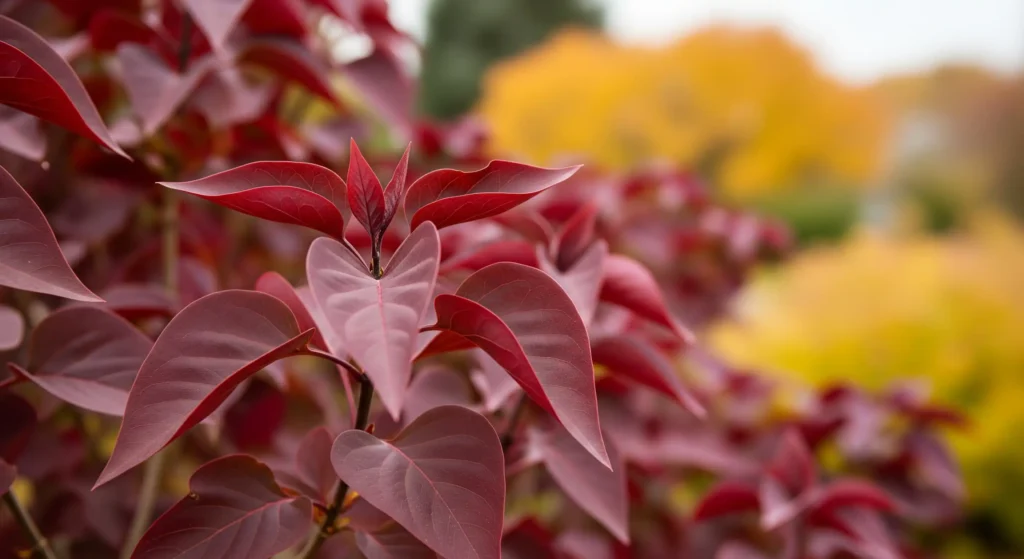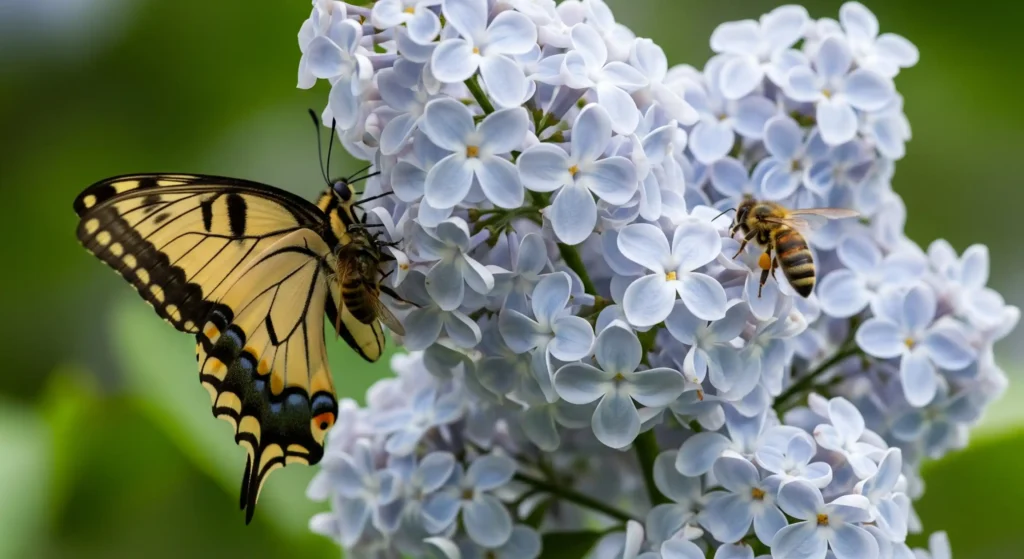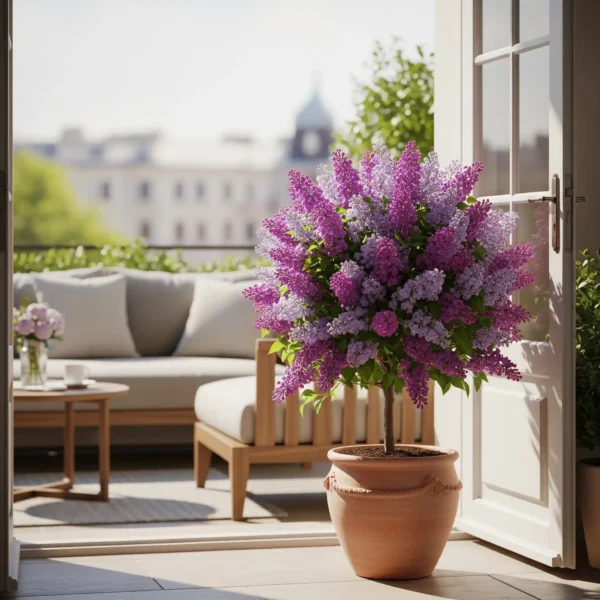“Miss Kim” Lilac Magic: The Simple Way to Grow and Care for This Small Beauty!
Hey there, other people who enjoy plants and gardens! If you’ve made it this far, you probably want to know more about the “Miss Kim” lilac, a lovely shrub that many people love. And let me tell you, you have great taste! This isn’t just any lilac; it’s a particular sort that makes the garden feel magical.
So you’re curious about how to take care of and grow ‘Miss Kim’ Lilac (Syringa patula ‘Miss Kim’)? You are in the correct place! It’s very rewarding to learn how to care for this lovely plant because “Miss Kim” is known for being very adaptable, having a lovely scent that can fill your whole yard, being the perfect size for modern gardens, and even having an unexpected splash of beautiful fall color. These are the things that really set it apart from other flowering shrubs.
Don’t be afraid of the word “care” now. “Miss Kim” will happily live in your garden for many, many years if you give it the right amount of sun, well-drained soil to wiggle its roots into, and a little knowledge about how to water and prune it. It’s more about knowing what it likes than following a complicated schedule.
This complete guide will show you everything you need to know, from picking the best site to plant your “Miss Kim” to making sure it blooms with those famous, sweet-smelling flowers every year. Get ready to love “Miss Kim.” Let’s discover how to make it grow!
Why “Miss Kim” Stands Out: A Look at Its Special Features
Why do so many gardeners love “Miss Kim”? This isn’t the big common lilac that your grandma used to have (but we love those too!). “Miss Kim” has a unique collection of traits that make it a great plant for the garden.
Compact and Manageable Size
The first thing is that it is little and easy to handle. “Miss Kim” usually grows to a very polite 4 to 8 feet tall and wide, unlike some of its bigger cousins that can soon overwhelm their surroundings. This is great for compact gardens, a nice addition to foundation plants, or a well-behaved star in mixed borders where space is limited.
Intoxicating Fragrance
And that smell! The smell! The flower buds start out as a deep lavender-purple color and then open up into exquisite panicles of icy-blue or pale lilac flowers. The scent is sweet, strong, and everything you want in a lilac. It can fill the air with its scent on a warm spring evening. It’s really heavenly.
Later Blooming Season
Compared to many other common lilacs, “Miss Kim” blooms later in the season. This can be a big plus in places where late spring frosts are common, as the flower buds are less likely to be damaged by a sudden cold snap. This means you can enjoy the lovely show.
Stunning Fall Color
The spring flowers aren’t the end of the show, though! Its stunning fall color is one of its greatest qualities and something that really sets it apart. In the fall, the leaves change into magnificent tones of burgundy-red. This is a nice extra, as many other types of lilacs don’t have much to offer in the fall. You can enjoy beauty all year long with “Miss Kim”!

Good Powdery Mildew Resistance
And for those of us who have fought off fungus, you’ll like that it has good powdery mildew resistance. This is a big plus over a lot of older types of Syringa vulgaris that get ugly with that white powdery coating, especially when it’s damp. “Miss Kim” usually looks fresh and healthy.
Botanical Background
For those who like to know the intricacies, its scientific name is Syringa patula ‘Miss Kim’ (you may also see it classified as Syringa pubescens subsp. patula ‘Miss Kim’). It was discovered in Korea and conveyed to the West, and what a great find it was!
Ideal Uses in the Landscape
Because of these qualities, “Miss Kim” has a lot of Ideal Uses in the Landscape. It looks great as a specimen plant, where you can really appreciate its interest over several seasons. It also works great as an informal hedge, fits wonderfully into perennial or shrub borders, and is a must-have near patios, windows, or walks where you can smell it up close.

It’s no surprise that “Miss Kim” is a favorite; she has so much to offer. Now, let’s plant it the right way!
How to Plant Your Syringa patula ‘Miss Kim’ So It Grows Well
To make sure your “Miss Kim” lilac lives a long and happy life, you need to give it a good start. Fortunately, planting this beauty isn’t hard, but paying attention to a few important elements will make a big difference.
The Best Time to Plant Your New Arrival
Most of the time, the best periods to grow ‘Miss Kim’ lilac are in the spring or fall. These times of year provide moderate temperatures and usually more reliable precipitation, which helps the plant build its root system without having to deal with the stress of excessive summer heat or deep winter cold.
Picking the Right Spot: Lots of Sun!
This might be the most important thing for a “Miss Kim” that blooms.
- Exposure: You must give them full exposure, which implies at least 6 to 8 hours of direct sunshine per day. This is very important for the optimum flower output and the health of the plant as a whole. In very hot places, “Miss Kim” might be okay with a little amount of dappled afternoon shade, but it really likes full sun. Less sun usually equals fewer flowers, and no one likes that!
- Air Circulation: Also, make sure that the air around the plant moves around well. This helps keep the leaves dry and makes it even less likely that any fungal problems would happen, even if “Miss Kim” is very resistant.
Preparing the soil is the key to success.
“Miss Kim” isn’t too picky about soil, but it does have some preferences for the best growth.
- Drainage: The soil needs to drain well. This is not up for discussion. Lilacs, like “Miss Kim,” hate having “wet feet” or resting in soil that is too wet. This can cause root rot, which is a very bad thing. You will need to change your heavy clay soil to make it drain better.
- Soil pH: The best pH for soil for “Miss Kim” is between 6.5 and 7.5, which is neutral to slightly alkaline. A basic soil test (you can obtain kits at most garden centers) is a good idea if you think your soil is particularly acidic. You can add garden lime to acidic soil to boost the pH if you need to.
- Soil Enrichment: Adding a lot of compost or other well-rotted organic matter to the soil in the planting area before planting is always a good idea. This makes the soil better by improving its structure, drainage (in heavy soils), and moisture retention (in sandy soils). It also supplies nutrients that are good for plants.
How to Plant Step by Step: Getting It Right
Now that you’ve picked a place and gotten the soil ready, here’s how to plant your “Miss Kim”:
- Digging the hole: Make a hole that is twice as broad as the plant’s root ball and the same depth as the root ball. The roots need a lot of loose soil to spread into.
- Gently loosening roots: Take the lilac out of its nursery pot with care. If the roots are firmly around the pot (pot-bound), gently pull them apart or make a few vertical cuts with a sharp knife. This makes the roots want to extend out into the new soil instead of staying in a circle.
- Putting the plant in the right place: Put the “Miss Kim” lilac in the middle of the hole. The most important thing to do is make sure that the top of the root ball is level with the ground around it. A lot of people make the mistake of planting too deep, which might cause problems.
- Backfilling: Start filling in the hole with the adjusted dirt you took out. As you go, carefully push it down around the root ball to get rid of big air pockets. But don’t stuff it too tightly.
- Watering deeply: After you fill the hole, give your new “Miss Kim” plant a deep and thorough watering. This helps the soil surrounding the roots settle and gives them the water they need.
Spacing Tips: Make Room for It to Shine
Keep in mind that “Miss Kim” will get 4 to 8 feet wide. When you plant it, make sure there is enough space between it and other plants, buildings, or walkways so that it may grow to its full size. Good spacing also helps with that very crucial air flow.
Taking care of “Miss Kim”: Ongoing care for lots of flowers and healthy growth
Once your “Miss Kim” lilac is happy in its new home, taking care of it is easy. This is not a diva who needs a lot of attention!
Watering Needs: Giving It the Right Amount of Water
Watering the right way is very important, especially in the first year.
- Newly Planted: Your “Miss Kim” will need regular water for the first growing season to help it create healthy roots. When the top inch or two of soil seems dry to the touch, water it deeply. This will happen more or less often depending on the type of soil and the weather.
- Established Plants: After the first year or two, “Miss Kim” becomes quite drought-tolerant. But it will still do better if you give it a deep watering during extended dry spells, especially in the summer when it’s hot or when it’s getting ready to bloom next year. Frequent, shallow watering should be avoided because it makes the roots grow shallow. It’s best to water less regularly but more deeply.
Fertilizing: This lilac doesn’t need as much as you think.
For gardeners who don’t want to deal with a lot of trouble, here’s some good news: “Miss Kim” doesn’t need a lot of food!
- It might not need any more fertilizer at all in most garden soils that are adequately rich.
- A modest application of a balanced, slow-release shrub fertilizer in early spring, when new growth starts, is typically enough if your soil is poor or you want to give it a little push.
- Be careful not to use too much nitrogen fertilizer. If you give your plants too much nitrogen, they will grow a lot of green leaves, which will often mean fewer blossoms. Some gardeners like to add a little bone meal (which is high in phosphorus) to the soil around the plant in early spring to help it bloom. Phosphorus can help flowers grow.
The benefits of mulching: it keeps the roots warm.
Putting a layer of organic mulch around your “Miss Kim” lilac is a simple thing to do that has many benefits.
- Put a 2- to 3-inch layer of organic mulch, like shredded bark, compost, wood chips, or pine straw, around the plant’s base. Make sure the mulch is a few inches away from the main stem or trunk so that moisture doesn’t build up against the bark and cause it to decay.
- Mulch is great because it keeps the soil moist by lowering evaporation, keeps weeds from competing for water and nutrients, and helps maintain the soil temperature stable by keeping the roots colder in the summer and warmer in the winter. The soil gets better over time as organic mulch breaks down.
How to Prune ‘Miss Kim’ Lilac to Keep It Shapely, Healthy, and Flowering
Pruning might be confusing when it comes to caring for lilacs, but it’s easy with “Miss Kim” provided you follow one important guideline. Proper pruning will help keep its lovely shape, let air circulate freely (which keeps diseases at bay), let you take out any dead or broken wood, and, in the end, encourage lots more flowers.
Why should you prune “Miss Kim”?
You want to maintain it looking well, make sure it’s healthy, and get the most out of those beautiful, fragrant flowers. A little shape, taking off dead flowers, and thinning every now and then can do a lot.
When to Cut Your “Miss Kim” by the Golden Rule
The most important thing to remember when trimming any lilac, including ‘Miss Kim,’ is to do it shortly after it blooms in late spring or early summer. Why is this so important? Lilacs, like “Miss Kim,” plant their bloom buds for the next year on “old wood,” which is the growth they make during the current summer. If you prune too late in the year, such in the fall or winter, you will almost surely clip off all of next year’s flower buds. And that would be a terrible thing!
A Simple List of What to Prune
When you have your pruners, here’s what to pay attention to:
- Deadheading, or cutting off spent flowers, is the most frequent way to prune “Miss Kim.” You can take off the gorgeous flower trusses once they have faded and turned brown. Cut the bloom stalk right above the first set of healthy leaves. Deadheading not only makes the plant look better, but it can also stop it from making seeds. This lets the plant focus more energy on growing leaves and possibly more blossoms the next year.
- You should always remove dead, damaged, or crossing branches as you see them, no matter what time of year it is. Cut cleanly back to healthy wood or the place where it came from. When branches cross and scrape against each other, they can make cuts that let illnesses in.
- Light Shaping: You may also conduct some light shaping shortly after the flowers fade to keep the plant’s shape or clean up any branches that are out of place.
- Suckers (if any): ‘Miss Kim’ doesn’t usually send up a lot of new shoots from the roots far away from the parent plant, like some common lilacs do. But if you notice any suckers growing at the base of the plant or from the roots, it’s better to cut them off as near to where they came from as you can.
- Renewal Pruning (for older, overgrown plants): If you have an older “Miss Kim” that has gotten a little thick or woody, you might want to think about doing a slow renewal pruning. You need to take off roughly a third of the oldest, thickest canes at the base of the plant every year for three years. This makes the plant sprout new, stronger, and more flower-filled growth from the root. Do this again shortly after the flowers bloom.
The Right Way to Prune
Use trimming tools that are sharp and clean all the time. For smaller stems, use bypass pruners, and for thicker stems, use loppers. Cut at a modest slant, usually about 1/4 inch above a healthy bud or a side branch that is developing outward.
Don’t ruin next year’s flowers by making these mistakes!
The most common mistake people make when trimming is doing it at the wrong time of year. Don’t give in to the impulse to undertake a lot of pruning on your “Miss Kim” from mid-summer to the next spring before it blooms. If you stick to that “right after flowering” timeframe for any big work, you’ll get a great show every year!
“Miss Kim’s” Star Qualities: Great Fall Color and Strong Disease Resistance
We’ve spoken about them previously, but two of “Miss Kim’s” best features really do deserve their own attention because they make it stand out from other lilac alternatives.
Amazing Fall Foliage: A Wonder All Year Round
One of the nice surprises about “Miss Kim” is that it becomes a gorgeous burgundy-red in the fall. This is something that not many other lilac types have. Most of them only become a dull yellowish-brown before shedding their leaves. The deep, warm colors of ‘Miss Kim’s’ fall leaves provide a great new level of interest to your garden that lasts long after the spring flowers have faded. It’s a nice way to say farewell to the growing season!
Great at keeping powdery mildew away: a breath of fresh air
You will really enjoy this trait of “Miss Kim” if you’ve ever grown common lilacs that get that ugly white, powdery coating of powdery mildew by mid-summer. It is very resistant to powdery mildew, a fungal disease that often affects other lilacs, especially in humid weather or in gardens with poor air circulation. This implies that your “Miss Kim” is far more likely to keep its clean, healthy-looking deep green leaves all season long, which means you won’t have to worry or do anything about it as much.
A Strong Choice for General Pest and Disease Outlook
No plant is completely safe from all possible problems, but “Miss Kim” is generally thought to be a strong and healthy shrub that can resist many common lilac pests and diseases. This is especially true when it is planted in full sun with well-drained soil and good air circulation, and when it is given the right care. Because it is naturally strong and resistant to disease, many gardeners find it to be a more reliable and low-maintenance choice.
Troubleshooting: Addressing Common ‘Miss Kim’ Lilac Questions & Concerns
Even though “Miss Kim” is a plant that doesn’t need much care, you could still have queries or worries from time to time. Let’s talk about some of the most popular ones:
“Why Isn’t My Lilac ‘Miss Kim’ Blooming?”
This is perhaps the question that lilac growers ask the most! Here are the most common reasons why your “Miss Kim” isn’t putting on the flower show you were hoping for:
- Not enough sun: This is by far the most common reason why lilacs don’t bloom well. Look at where it is again. Is it really getting 6 to 8 hours of direct sunlight every day? The trees nearby may have grown and started to block more light than you thought.
- Pruning at the Wrong Time: Did you or someone else prune it in the fall, winter, or early spring before it had a chance to bloom? If so, those flower buds that were so important were probably taken away. Always remember the golden rule: only prune after the flowers have bloomed!
- Too much nitrogen fertilizer: High nitrogen levels make plants develop more leaves, which can stop flowers from growing. If you use a high-nitrogen fertilizer on your lawn nearby, some of it can get to your lilac. Use low-nitrogen or balanced fertilizers on your “Miss Kim” only when you need to.
- The plant is too young: Newly planted lilacs, especially smaller ones, may need a year or two to grow their roots and mature before they start to bloom a lot. It will take some time.
- Stress: A lilac’s ability to make flower buds or bloom well can be affected by long periods of excessive drought, saturated soil, or other major environmental stressors.
You can read more details about it in this article: Lilac Not Blooming? 7 Reasons Why & How to Fix It!
Small Problems or Leaf Spots
You might observe some small spots on the leaves from time to time, especially when it’s really rainy or humid. Most of the time, these are small fungal problems. Most of the time, the best thing to do is:
- Make sure the plant gets enough air.
- When you water, don’t get the leaves wet.
- To cut down on the number of spores, take off and throw away any leaves that are very marked.
- These small patches don’t usually become a big concern because “Miss Kim” is very resistant to sickness.
How tough is it in the winter?
The ‘Miss Kim’ lilac is a tough shrub that does well in USDA hardiness zones 3 through 8. This means that it can handle very cold winters and do rather well in places with warmer summers, as provided as its other demands, such sun and drainage, are met.
“Miss Kim” in Your Landscape: Ideas for Design and the Best Plants to Pair
The ‘Miss Kim’ lilac is a great plant for the garden because it is small, has gorgeous flowers, smells great, and adds color in the fall. Here are some ideas to get you started:
Different Ways to Use “Miss Kim” in the Landscape
- Foundation Plantings: Because it doesn’t get too big, it’s a great choice for planting close to the house, where it won’t block windows or paths like bigger lilacs can.
- Mixed Borders: “Miss Kim” goes well with many other perennials and shrubs, bringing structure and a spring scent.
- Specimen Plant: It’s definitely pretty enough to be the main attraction in a little garden or a particular place.
- Low Hedge: When planted in a row, “Miss Kim” can make a lovely, fragrant, casual hedge that is much easier to take care of than hedges formed from bigger lilac types.
- Near Patios or Walkways: What could be better than putting it where you can smell its seductive scent up close while you relax outside or walk through your garden?
- Large Containers: Most shrubs do better when they are planted in the ground, but you may grow “Miss Kim” in a very large container for a few years if you don’t have a lot of room in your yard. Just make sure the container has good drainage and that you water and feed it every now and then.
Good Companion Plants: Making Beautiful Combinations
“Miss Kim” gets along well with a lot of other garden favorites! When picking plants to go with it, think about things like bloom timing (plants that bloom at the same time or provide interest before or after), color, texture, or cultural demands (plants that also like full light and well-drained soil). Here are some nice combinations:
- Bulbs that bloom in the spring, such tulips, daffodils, and grape hyacinths, can be planted around its base to make a magnificent early spring show before “Miss Kim” takes center stage.
- Peonies: Their full, passionate flowers generally bloom at the same time as or after lilacs, making them a traditional spring companion.
- Iris: The sword-like leaves and detailed petals of irises provide a great contrast.
- Catmint (Nepeta): The soft, billowy, blue-purple flowers of catmint are a classic companion for many shrubs and perennials. They bloom for a long time.
- Salvia (Perennial Sage): The spiky blue or purple flowers of ‘May Night’ or ‘Caradonna’ look great with ‘Miss Kim’.
- Later Season Bloomers: These plants, cone flowers (Echinacea) and daylilies (Hemerocallis), will add color and interest to your garden later in the season, after “Miss Kim” has stopped blooming.
- Evergreen Shrubs: Boxwood and other evergreen shrubs may add structure to your garden and provide foliage all year round to go with your lilac.
In conclusion, enjoy the lasting beauty and scent of your “Miss Kim” lilac.
There you have it! It is a real pleasure to learn how to grow and care for ‘Miss Kim’ Lilac. The results are a shrub that will make your yard look and smell great for many years. It doesn’t ask for much, yet it provides a lot in return.
‘Miss Kim’ is a really special variety because of its intoxicating scent that fills the spring air, its beautiful icy-blue to lavender flowers, its perfectly compact and manageable size that fits so well into modern landscapes, its stunning burgundy-red fall color, and its great disease resistance.
The ‘Miss Kim’ lilac is a great addition to practically any sunny garden because it is generally easy to care for and has many appealing qualities. Plant one, follow the care suggestions we’ve talked about, and get ready to be completely amazed by its lasting beauty and heavenly aroma season after season. Have fun gardening!
Questions that people often ask about “Miss Kim” Lilac
How big does a lilac called “Miss Kim” usually get?
People love “Miss Kim” because it doesn’t take up much space. It normally grows to be around 4 to 8 feet tall and wide. This makes it a lot smaller and easier to handle than most typical lilacs, which can grow to be 12 to 15 feet tall or more.
Does the “Miss Kim” lilac smell good?
Yes, definitely! It’s famous for its strong and sweet smell. Many gardeners think its smell is very nice, and they often say it smells spicy and rich. It’s especially nice and apparent on warm spring evenings when the smell can be carried by the wind.
Do butterflies and bees prefer the lilac “Miss Kim”?
Yes, that’s right! Pollinators love the sweet-smelling blossoms of ‘Miss Kim’ lilac, which are full of nectar. In the garden, it’s always nice to see butterflies flitting around and bees buzzing cheerfully amid the flowers. Hummingbirds might even come around sometimes.

Is “Miss Kim” lilac better at handling heat or warmer areas than some other lilacs?
Yes, “Miss Kim” is noted for being able to handle heat better and needing less cold weather to establish flower buds than many other types of lilacs (Syringa vulgaris). This makes it a better candidate for the warmer areas of its hardiness zone. People usually think it’s hardy in USDA zones 3 through 8. It does well even in places with hot summers, as long as it gets enough water and, if possible, some shade from the hottest afternoon sun in the hottest zones.
How often should I give my established ‘Miss Kim’ lilac water?
Your “Miss Kim” lilac will be able to handle dry weather well once it has been in the ground for a year or two. During long dry spells, especially in the summer, you’ll want to give it a lot of water. A good rule of thumb is to let the soil dry up a little bit between waterings. Check the top few inches. Lilacs don’t like damp feet, so don’t keep the soil too wet all the time.









